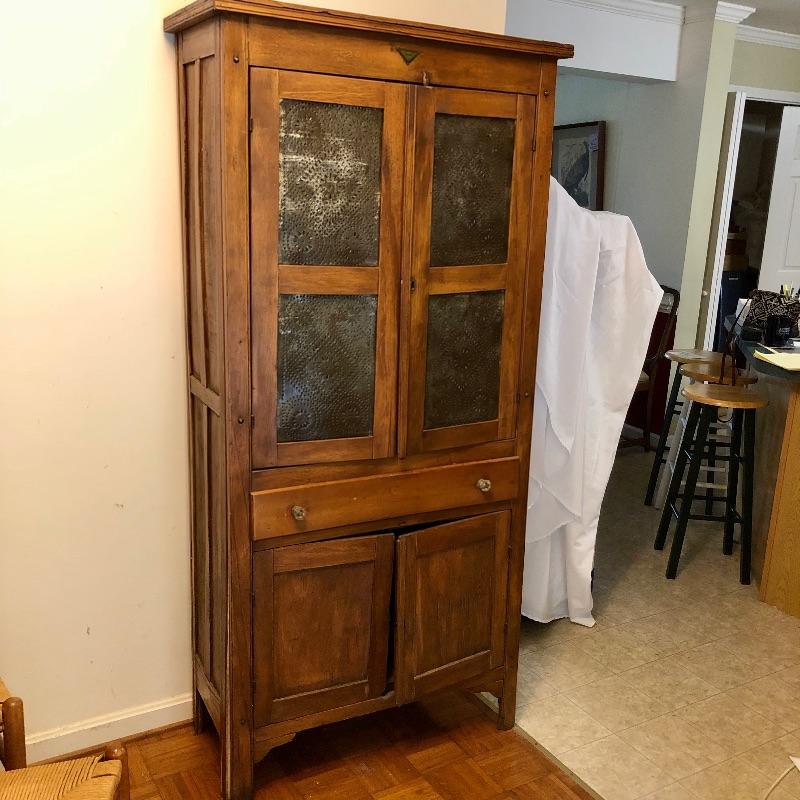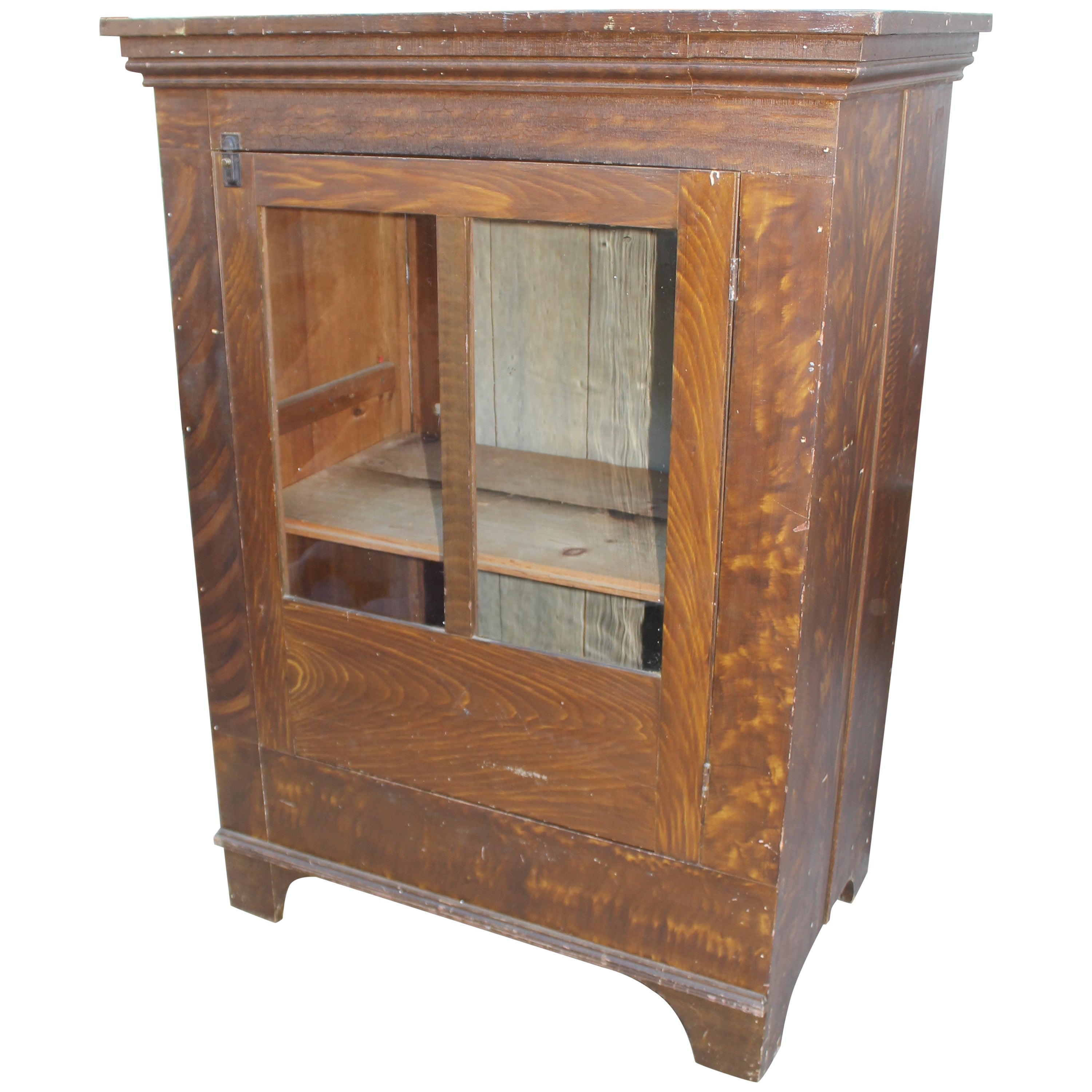History and Origins of the Black Pie Safe Cabinet

The black pie safe cabinet, a distinctive and functional piece of furniture, holds a significant place in American history, reflecting the ingenuity and resourcefulness of early settlers. Its origins can be traced back to the 18th century, evolving alongside the development of American culinary traditions and the need for efficient food storage.
The black pie safe cabinet emerged as a practical solution to the challenges of food preservation in a time before widespread refrigeration. The cabinet’s design, with its numerous small compartments and slatted doors, facilitated air circulation, which was crucial for keeping food fresh and preventing spoilage. The use of black paint, often a mixture of lampblack and linseed oil, served a dual purpose: it absorbed heat, creating a cooler environment inside the cabinet, and it deterred pests from accessing the stored food.
The black pie safe cabinet, with its intricate latticework and dark wood, is a testament to the practicality and elegance of a bygone era. This iconic piece, often adorned with metal accents, embodies the classic pairing of black and metal, a design choice that transcends time.
This pairing echoes the timeless appeal of white cabinet black hardware , where the contrast between the light and dark creates a visually striking and enduring aesthetic. Just as black hardware elevates the simplicity of a white cabinet, the metal accents on a black pie safe cabinet add a touch of sophistication to its functional design.
Materials and Construction
The construction of black pie safe cabinets varied over time, reflecting the availability of materials and the evolving skills of cabinetmakers. Early examples were often crafted from readily available woods like pine, maple, or oak.
- Early Construction: The construction techniques of early pie safes involved simple joinery, such as mortise and tenon joints, to assemble the frame. The doors were often made from thin, slatted panels, allowing for airflow while keeping out dust and insects.
- Later Construction: As woodworking techniques advanced, later pie safes incorporated more elaborate joinery, including dovetail joints, and the use of hardwoods such as cherry or walnut. The doors were sometimes adorned with decorative details, such as raised panels or carved trim.
Cultural Significance
The black pie safe cabinet was more than just a piece of furniture; it was a symbol of domesticity and resourcefulness in early American households. It played a vital role in preserving food, ensuring the family’s well-being throughout the year.
- Food Preservation: Pie safes were essential for storing baked goods, fruits, vegetables, and other perishable items, extending their shelf life and allowing families to enjoy fresh food even during the winter months.
- Household Organization: Beyond food storage, pie safes often served as a central hub for household organization, housing linens, utensils, and other essential items. Their presence in the kitchen or dining room signified a sense of order and efficiency in the home.
Design and Features of Black Pie Safe Cabinets

Black pie safe cabinets, also known as “safe” cabinets, are a distinctive type of furniture that emerged in the 18th century, primarily in the American colonies. They were designed to store food, particularly baked goods, and protect them from pests and spoilage. The distinctive design features of these cabinets, a blend of practicality and aesthetics, played a crucial role in their functionality and appeal.
The unique design of black pie safe cabinets was a direct response to the needs and conditions of the time. These cabinets were constructed to provide a secure and efficient storage solution for food, particularly in an era before widespread refrigeration.
Doors
The doors of black pie safe cabinets were often constructed using a variety of materials, including wood, metal, or a combination of both. They were typically designed with a series of small, overlapping panels, known as “pie safe” panels. These panels served a dual purpose: to provide ventilation and to deter pests. The spaces between the panels allowed air to circulate, helping to prevent moisture buildup and mold growth. The small size of the panels also made it difficult for pests, such as rodents and insects, to gain access to the stored food.
Shelves
The shelves within black pie safe cabinets were typically constructed of wood, often with a simple design. They were designed to be adjustable, allowing for the storage of items of varying sizes. The shelves were often spaced to accommodate the specific needs of the household, such as the storage of pies, cakes, or other baked goods.
Ventilation
Ventilation was a crucial design element in black pie safe cabinets. The doors, as described earlier, were designed with small panels to allow for air circulation. Additionally, many pie safe cabinets included additional ventilation features, such as louvers or open spaces at the back or sides of the cabinet. These features helped to maintain a dry and airy environment, preventing moisture buildup and spoilage.
Decorative Features
While functionality was paramount, black pie safe cabinets also incorporated decorative features that enhanced their aesthetic appeal. These features included:
- Turned legs: These legs provided structural support and added a decorative touch. The legs were often turned on a lathe, creating a variety of patterns and shapes.
- Moldings: Moldings were often used to frame the doors, shelves, and other elements of the cabinet, adding visual interest and a sense of refinement.
- Hardware: The hinges, latches, and handles used on black pie safe cabinets were often made of brass, iron, or other durable materials. They were often crafted with decorative details, such as scrollwork or floral motifs.
- Paint: Black pie safe cabinets were often painted in dark colors, such as black or dark green, to help protect the wood from the elements and to create a sense of formality.
Regional and Temporal Variations, Black pie safe cabinet
The design and construction of black pie safe cabinets varied across different regions and time periods.
- Regional variations: In the Northeast, black pie safe cabinets were often characterized by their simple construction and use of local hardwoods. In the South, they were more likely to be made with pine or other softwoods, and often featured more elaborate decorative details. In the Midwest, black pie safe cabinets were often influenced by the styles of both the Northeast and the South.
- Temporal variations: The design of black pie safe cabinets evolved over time, reflecting changing styles and preferences. Early pie safe cabinets were often characterized by their simple construction and utilitarian design. Later cabinets, particularly those produced in the Victorian era, often featured more elaborate decorative details, such as intricate carvings and painted designs.
Black Pie Safe Cabinets in Modern Times

The enduring appeal of black pie safe cabinets extends beyond their historical significance. These versatile pieces of furniture continue to find a place in contemporary homes and businesses, blending seamlessly with modern design aesthetics and serving a variety of practical purposes.
Revival of Interest in Black Pie Safe Cabinets
The resurgence of interest in antique and reproduction black pie safe cabinets can be attributed to several factors. The timeless elegance and craftsmanship of these cabinets appeal to those seeking unique and statement pieces for their homes. Their functionality as storage solutions also resonates with contemporary lifestyles, offering a practical alternative to bulky cabinets and open shelving. The rise of farmhouse and rustic decor trends has further fueled the demand for these charming cabinets, incorporating them into a wide range of interior design styles.
Contemporary Uses and Applications
Black pie safe cabinets are no longer confined to kitchens or dining rooms. Their versatility allows them to be incorporated into various spaces and serve diverse purposes.
- Kitchen Storage: Pie safe cabinets continue to be popular in kitchens, providing ample storage for dishes, cookware, and pantry items. Their open shelves allow for easy access and ventilation, keeping food fresh and organized.
- Dining Room Accent: Used as a buffet or hutch, black pie safe cabinets can enhance the ambiance of a dining room. They provide a stylish display space for china, glassware, and decorative items, while offering practical storage for linens and serving pieces.
- Living Room Entertainment Center: In living rooms, pie safe cabinets can be repurposed as entertainment centers. The enclosed shelves can house electronics, while the open shelves provide display space for books, plants, or decorative items.
- Entryway Storage: Pie safe cabinets are also a practical addition to entryways, offering storage for hats, gloves, shoes, and other essentials. Their open shelves provide a convenient place to display keys, mail, or decorative items.
- Office Organization: The functional design of black pie safe cabinets makes them ideal for office organization. The enclosed shelves can store files and office supplies, while the open shelves provide a place for displaying books, plants, or decorative items.
- Retail Displays: In retail settings, pie safe cabinets can be used as eye-catching displays for merchandise. The open shelves allow for showcasing products, while the enclosed shelves provide storage space for inventory.
Incorporating Black Pie Safe Cabinets into Modern Interior Design
Black pie safe cabinets can be integrated into a variety of modern interior design styles, adding a touch of history and charm to contemporary spaces.
- Farmhouse Chic: The rustic appeal of black pie safe cabinets aligns perfectly with farmhouse chic design. Paired with distressed wood furniture, natural textiles, and vintage accents, these cabinets create a cozy and inviting ambiance.
- Industrial Modern: The sleek lines and dark tones of black pie safe cabinets complement industrial modern aesthetics. Combining these cabinets with metal accents, exposed brick walls, and Edison bulb lighting creates a stylish and functional space.
- Minimalist: Despite their intricate details, black pie safe cabinets can be incorporated into minimalist design schemes. Choose a simple, unadorned cabinet and pair it with sleek, modern furniture and accessories.
- Transitional: Black pie safe cabinets can bridge the gap between traditional and contemporary styles in transitional design. Their classic elegance complements modern furniture and finishes, creating a balanced and harmonious look.
The black pie safe cabinet, with its intricate carvings and sturdy construction, speaks to a bygone era of craftsmanship and practicality. While its purpose may have shifted from storing food to displaying treasured heirlooms, the cabinet’s timeless appeal endures.
Similarly, the search for a comfortable and affordable living space continues, with many seeking 2 bedroom apartments under $1000 to accommodate their needs. Just as the pie safe cabinet offered a secure and organized solution for preserving food, finding a suitable apartment provides a foundation for building a life.
The black pie safe cabinet, a testament to the past, reminds us of the enduring value of functional and aesthetically pleasing design, a quality that is equally sought after in modern living spaces.
